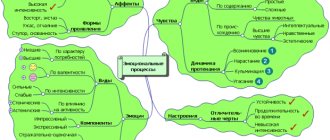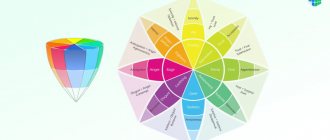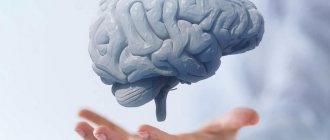More than feelings
Affect is a rather intense, but short-term outburst of emotional sensations. Examples: uncontrollable anger, rage, intense joy, despair. It absolutely completely subjugates the psyche, while creating a complex complex that predetermines the attitude towards what is happening.
The main feature is that the sense of reality is lost. A person may not understand what he is doing. Typically, people in this state make long, erratic movements. Another option is complete numbness, speechlessness. Often after such a stormy spectrum you can feel very tired and depressed.
Passion is a complex state, focused on a large number of sensations, given only to man. It can be focused both around a specific activity and around an object.
General characteristics of emotions
Definition 1
Emotions are mental processes that occur in the form of experiences and reflect the intensity of current motivation and the prospect of its satisfaction in a given specific situation.
There is another definition of emotional states.
Definition 2
Emotional states are functions of two variables:
- The person’s current motivation;
- There is a probability of its satisfaction.
A person’s emotional states are closely related to the process of regulating human activity as a whole and are reflected in a person’s behavioral reactions. Many researchers are of the opinion that a person’s emotional manifestations, on the one hand, are genetically determined, and on the other hand, they are socially predisposed.
Are you an expert in this subject area? We invite you to become the author of the Directory Working Conditions
Human emotional manifestations exist in the form of:
- a person’s internal subjective experiences;
- changes in human facial expressions, gestures and pantomime;
- characteristic changes in human behavior;
- speech changes;
- hormonal changes;
- emerging vegetative reactions.
Emotions are a universal reaction of the entire human body to the external influence of the surrounding world.
Differences between emotions and feelings, their classification and functions
Emotions are a broader concept that is universal in nature for all people (they do not affect the historical nature), and may not have a substantive character.
Classification of feelings
Feelings can be divided into:
- Intellectual, arising in the process of study/scientific work.
- Moral, which reflect a person’s attitude to morality.
- Aesthetic, resulting from receiving aesthetic pleasure.
Sharing emotions
According to the sign of emotions there are:
- positive – joy, interest;
- negative - fear, anger and rage.
In terms of impulse and duration, mood and a stable emotional state help characterize all experiences.
According to the degree of activity of the body:
- Stenic shakes the body and improves mood (rage, delight).
- Asthenic relaxes and suppresses activity (melancholy, sadness, shame).
Functions of emotions
Emotions have their own functions:
- Grade. Allows you to quickly assess the situation and direct the processing of information in the right direction.
- Mobilization. Responsible for increasing the physical capabilities of the body when adrenaline is released into the blood.
- Trace formation. Appears after some exciting event.
- Compensating for information deficiency. In other words - intuition.
- Communication.
- The ability to empathize with others.
Theories of emotions
There are various theories of emotions:
- Evolutionary. Charles Darwin's theory, illustrating the similarities in behavior between humans and animals. Emotions emerged as a result of evolution as vital adaptive mechanisms.
- Rudimentary. According to it, human experiences are residual manifestations of full-fledged movements in the distant past.
- Psychoanalytic. According to Sigmund Freud, emotion is the residual energy of the nervous system that helps to adapt to society.
- Structural. James Paperz argued that sensation is controlled at a deep structural level.
- Organic. According to W. James and K. Lange, worries are conscious manifestations of functional changes at the level of the autonomic system.
- Biological. Peter Anokhin was sure that the entire emotional background is the key to satisfying physical needs.
- Informational. Developing the previous theory, Pavel Simonov considered emotional impulses as a model of behavior at a given time and place.
It would seem that seemingly simple feelings have many prerequisites. The spectrum of all human emotions cannot be measured. Studying them will help you learn to more deeply analyze and control your deepest feelings.
TYPES OF EMOTIONAL PROCESSES AND STATES
Emotions
- a special class of subjective psychological states that reflect, in the form of direct experiences of pleasure, the process and results of practical activities aimed at satisfying its current needs. Since everything that a person does ultimately serves the purpose of satisfying his various needs, any manifestations of human activity are accompanied by emotional experiences.
The oldest in origin, the simplest and most widespread form of emotional experiences among living beings is pleasure,
received from satisfying organic needs, and the displeasure associated with the inability to do this when the corresponding need intensifies.
The main emotional states that a person experiences are divided into actual emotions
,
feelings
and
affects
.
Emotions and feelings
anticipate the process aimed at satisfying a need, have an ideational character and are, as it were, at the beginning of it. Emotions and feelings express the meaning of a situation for a person from the point of view of a currently relevant need, the significance of an upcoming action or activity to satisfy it. Emotions can be caused by both real and imagined situations. They, like feelings, are perceived by a person as his own internal experiences, communicated, i.e. are transmitted to other people, empathize.
Feelings
– the highest product of human cultural and emotional development. They are associated with certain cultural objects, activities and people surrounding a person.
Feelings play a motivating role in a person’s life and activity, in his communication with people around him. In relation to the world around him, a person strives to act in such a way as to reinforce and strengthen his positive feelings. They are always connected with the work of consciousness and can be voluntarily regulated.
Affects
– these are especially pronounced emotional states, accompanied by visible changes in the behavior of the person who experiences them. Affect does not precede behavior, but is, as it were, shifted to its end.
The development of affect is subject to the following law: the stronger the initial motivational stimulus of behavior and the more effort had to be spent on implementing it, the smaller the result obtained as a result of all this, the stronger the resulting affect. Unlike emotions and feelings, affects occur violently, quickly, and are accompanied by pronounced organic changes and motor reactions.
Affects, as a rule, interfere with the normal organization of behavior and its rationality. They are capable of leaving strong and lasting traces in long-term memory. Unlike affects, the work of emotions and feelings is associated primarily with short-term and operative memory. Emotional tension arising as a result of affectogenic situations can accumulate and, if it is not released in time, lead to a strong and violent emotional release, which, while relieving the resulting tension, is often accompanied by a feeling of fatigue, depression, and depression.
Passion
- another type of complex, qualitatively unique and occurring only in humans emotional states. Passion is a fusion of emotions, motives and feelings concentrated around a certain type of activity or object (person).
STRESS AND FRUSTRATION
One of the most common types of affect these days is stress.
. It is a state of excessively strong and prolonged psychological stress that occurs in a person when his nervous system receives emotional overload. Stress disorganizes a person’s activities and disrupts the normal course of his behavior. Stress, especially if it is frequent and prolonged, has a negative impact not only on a person’s psychological state, but also on a person’s physical health. They represent the main “risk factors” for the manifestation and exacerbation of cardiovascular disorders and diseases of the gastrointestinal tract.
Translated from English, stress is pressure, pressure, tension, and distress is grief, unhappiness, malaise, need. According to G. Selye, stress is a nonspecific (i.e., the same to different influences) response
the body to any demand presented to it, which helps it adapt to the difficulty that has arisen and cope with it. Any surprise that disrupts the usual course of life can cause stress. At the same time, as G. Selye notes, it does not matter whether the situation we are faced with is pleasant or unpleasant. All that matters is the intensity of the need for restructuring or adaptation. As an example, the scientist cites an exciting situation: a mother, who was informed about the death of her only son in battle, experiences terrible mental shock. If, many years later, it turns out that the message was false and her son suddenly enters the room unharmed, she will feel intense joy.
Activities associated with stress can be pleasant or unpleasant. Any event, fact or message can cause stress, i.e. become a stressor.
Whether this or that situation is a cause of stress or not depends not only on the situation itself, but also on the individual, her experience, expectations, self-confidence, etc. Of particular importance, of course, is the expectation of dangerous consequences and the assessment of the threat that the situation contains.
This means that the very occurrence and experience of stress depends not so much on objective as on subjective factors, on the characteristics of the person himself: his assessment of the situation, comparison of his strengths and abilities with what is required of him, etc.
frustration is close to the concept and state of stress.
. The term itself, translated from Latin, means deception, futile expectation. Frustration is experienced as tension, anxiety, despair, anger that engulfs a person when, on the way to achieving a goal, he encounters unexpected obstacles that interfere with the satisfaction of a need.
Frustration thus creates, along with the original motivation, a new, defensive motivation aimed at overcoming the obstacle that has arisen. Old and new motivations are realized in emotional reactions.
The most common reaction to frustration is the emergence of aggression, most often directed at obstacles. The appropriate response to an obstacle is to overcome or bypass it if possible; aggressiveness, quickly turning into anger, manifests itself in violent and inadequate reactions: insult, physical attacks on a person (pinching, hitting, pushing) or an object (breaking it).
Retreat and departure.
In some cases, the subject responds to frustration by withdrawing (eg, leaving the room), accompanied by aggression that is not overtly expressed.
Frustration leads to emotional disturbances only when there is an obstacle to strong motivation. If a pacifier is taken away from a child who has started drinking, he reacts with anger, but at the end of sucking there are no emotional manifestations.
Basic functions of human emotions
- Regulatory function;
- The reflective function, which consists in a person’s ability to make a generalized assessment of certain events and determines the usefulness or harmfulness of facts. This function is formed in the process of communicating with other people and acquiring personal experience;
- Signaling or orienting function, consisting of monitoring one’s own behavior and activities;
- Incentive or stimulating function;
- Reinforcing function;
- A switching function that manifests itself in moments of competition between the motives of human activity.
- An adaptive function that helps a person adapt to the world around him;
- A communicative function that influences surrounding people and the process of organizing interaction with them.
Get paid for your student work
Coursework, abstracts or other works











